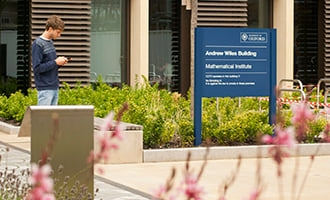
Mathematics and Statistics
Course overview
UCAS code: G100
Entrance requirements: A*A*A with the A*s in Maths and Further Maths if available.
Course duration: 3 years (BA); 4 years (MMath)
Subject requirements
Required subjects: Maths
Recommended subjects: Further Maths
Helpful subjects: Not applicable
Other course requirements
Admissions tests: MAT
Written Work: None
Admissions statistics*
Combined statistics for Mathematics and Mathematics and Statistics:
Interviewed: 31%
Successful: 9%
Intake: 182
*3-year average 2022-24
Maths contact
Email: undergraduate.admissions@maths.ox.ac.uk
Statistics contact
Email: undergraduate.admissions@stats.ox.ac.uk
Unistats information for this course can be found at the bottom of the page
Please note that there may be no data available if the number of course participants is very small.
About the course
All over the world, human beings create an immense and ever-increasing volume of data, with new kinds of data regularly emerging from science and industry. A new understanding of the value of these data to society has emerged, and with it, a new and leading role for statistics.
In order to produce sensible theories and draw accurate conclusions from data, cutting-edge statistical methods are needed. These methods use advanced mathematical ideas combined with modern computational techniques, which require expert knowledge and experience to apply.
A degree in Mathematics and Statistics equips you with the requisite skills for developing and implementing these methods. The course provides a fascinating combination of deep and mathematically well-grounded method-building and wide-ranging applied work with data.
The Department of Statistics at Oxford is an exciting and dynamic place to study, with teaching and research strengths in a wide range of modern areas of statistical science. Many of its academic staff work in the development of fundamental statistical methodology and probability. There is a strong new research group working on statistical machine learning and scalable methods for Big Data.
The department has a world-leading team applying new statistical methods to huge genetic data sets in order to unlock the secrets of human genetic variation and disease. Other groups work on applied probability, network analysis, and medical, actuarial and financial applications. These interests are reflected in the lecture courses available to undergraduates in their third and fourth years.
 | 'I find the range of practical applications for statistics really appealing. I heard a talk about the uses of statistics at a Maths open day, and immediately knew that this would be the right course for me. Henry |
Unistats information
Discover Uni course data provides applicants with Unistats statistics about undergraduate life at Oxford for a particular undergraduate course.
Please select 'see course data' to view the full Unistats data for Mathematics and Statistics.
Please note that there may be no data available if the number of course participants is very small.
Visit the Studying at Oxford section of this page for a more general insight into what studying here is likely to be like.
Mathematics and Statistics
A typical week
The typical week of a student in Mathematics and Statistics is similar to that for Mathematics:
- Years 1 and 2: around ten lectures and 2–3 tutorials or classes a week
- Years 3 and 4: 8–12 lectures and 2–4 classes a week, depending on options taken. (Courses involving statistical software packages have some lecture hours replaced by teaching sessions in labs).
Tutorials are usually 2-4 students and a tutor. Class sizes may vary depending on the options you choose. There would usually be around 8-12 students though classes for some of the more popular papers may be larger.
Most tutorials, classes, and lectures are delivered by staff who are tutors in their subject. Many are world-leading experts with years of experience in teaching and research. Some teaching may also be delivered by postgraduate students who are usually studying at doctorate level.
Visit our Academic Year page to find out more about how our teaching year is structured.
Course structure
The first year of this course is identical to Mathematics, and the core mathematics part of the degree is completed in the first term of the second year.
You will also follow second-year Mathematics courses in probability and statistics, and the remainder of the second year allows for some choice of topics in preparation for the greater selectivity of the third and fourth years.
Admission to this course is joint with Mathematics, and applicants do not choose between the two degrees until the end of their fourth term at Oxford. At that point, all students declare whether they wish to study Mathematics or study Mathematics & Statistics. Further changes later on may be possible subject to the availability of space on the course and the consent of the college.
There are two Mathematics and Statistics degrees, the three-year BA and the four-year MMath. Decisions regarding continuation to the fourth year do not have to be made until the third year. All third- and fourth-year mathematical topics available in the Mathematics course are also available to Mathematics and Statistics students. The fourth year is naturally more challenging and provides an opportunity for more in-depth study, including a substantial Statistics project.
Year 1
Courses | Assessment |
|---|---|
Compulsory Year 1 includes:
|
First University examinations: five compulsory papers; Computational mathematics projects |
Year 2
Courses | Assessment |
|---|---|
Current core courses:
Current options:
|
Final University examinations, Part A: five core papers and four or five optional papers |
Year 3
Courses | Assessment |
|---|---|
Current options include:
|
Final University examinations, Part B: the equivalent of eight written papers including assessed practicals |
Year 4
Courses | Assessment |
|---|---|
Current options include:
The options listed above are illustrative and may change. A full list of current options is available on the Mathematics and Statistics websites. |
Final University examinations, Part C: the equivalent of eight written papers. |
The content and format of this course may change in some circumstances. Read further information about potential course changes.
Academic requirements
Qualification | Requirement |
|---|---|
A-levels: | A*A*A with the A*s in Mathematics and Further Mathematics (if available). For those for whom A-level Further Mathematics is not available: either A*AAa with A* in Mathematics and a in AS-level Further Mathematics or A*AA with A* in Mathematics. |
Advanced Highers: | AA/AAB |
International Baccalaureate (IB): | 39 (including core points) with 766 at HL (the 7 must be in Higher Level Mathematics) |
Any other equivalent qualification: | View information on other UK qualifications, and international qualifications. |
Wherever possible, your grades are considered in the context in which they have been achieved.
Read further information on how we use contextual data.
Subject requirements
Essential: | Candidates are expected to have Mathematics to A-level (A* grade), Advanced Higher (A grade), Higher Level in the IB (score 7) or another equivalent. |
|---|---|
Recommended: | Further Mathematics is highly recommended. |
The majority of those who read Mathematics will have taken both Mathematics and Further Mathematics at A-level (or the equivalent).
If a practical component forms part of any of your science A‐levels used to meet your offer, we expect you to pass it.
If English is not your first language you may also need to meet our English language requirements.
Applying
All candidates must follow the application procedure as shown on our Applying to Oxford pages.
The following information gives specific details for students applying for this course.
Admissions test
Test: | MAT |
|---|---|
Test dates: | 22 & 23 October 2025 |
Registration window: | To be confirmed |
All candidates must take the Mathematics Admissions Test (MAT) as part of their application.
All the information you need to arrange to take your test as well as how best to prepare can be found on your test page.
Written work
You do not need to submit any written work when you apply for this course.
What are tutors looking for?
Tutors are looking for a candidate’s potential to succeed on the course. We recommend that candidates challenge themselves with Mathematics beyond their curriculum, question their own understanding, and take advantage of any available extension material.
Ultimately, we are most interested in a candidate’s potential to think imaginatively, deeply and in a structured manner about the patterns of mathematics.
Visit the Maths Department website for more detail on the selection criteria for this course.
Careers
In recent years, 96% of Mathematics and Statistics graduates and 95% of Mathematics graduates were in work or further study six months after graduation. The majority have joined the insurance and financial services professions, but there are a wide range of options for graduates whose studies have included a substantial amount of statistics and applied probability.
There is great demand for those wishing to work in the relatively new area of data science, while careers in fields as diverse as health, technology, education and industry are all possible.
Note: These annual fees are for full-time students who begin this undergraduate course here in 2025. Course fee information for courses starting in 2026 will be updated in September.
We don't want anyone who has the academic ability to get a place to study here to be held back by their financial circumstances. To meet that aim, Oxford offers one of the most generous financial support packages available for UK students and this may be supplemented by support from your college.
Fees
Fee status | Annual Course fees |
| Home | £9,535 |
| Overseas | £44,880 |
Further details about fee status eligibility can be found on the fee status webpage.
For more information please refer to our course fees page. Fees will usually increase annually. For details, please see our guidance on likely increases to fees and charges.
Living costs
Living costs at Oxford might be less than you’d expect, as our world-class resources and college provision can help keep costs down.
Living costs for the academic year starting in 2025 are estimated to be between £1,425 and £2,035 for each month you are in Oxford. Our academic year is made up of three eight-week terms, so you would not usually need to be in Oxford for much more than six months of the year but may wish to budget over a nine-month period to ensure you also have sufficient funds during the holidays to meet essential costs. For further details please visit our living costs webpage.
Financial support
Home | A tuition fee loan is available from the UK government to cover course fees in full for Home (UK, Irish nationals and other eligible students with UK citizens' rights - see below*) students undertaking their first undergraduate degree**, so you don’t need to pay your course fees up front. In 2025 Oxford is offering one of the most generous bursary packages of any UK university to Home students with a family income of around £50,000 or less, with additional opportunities available to UK students from households with incomes of £32,500 or less. The UK government also provides living costs support to Home students from the UK and those with settled status who meet the residence requirements. *For courses starting on or after 1 August 2021, the UK government has confirmed that EU, other EEA, and Swiss Nationals will be eligible for student finance from the UK government if they have UK citizens’ rights (i.e. if they have pre-settled or settled status, or if they are an Irish citizen covered by the Common Travel Area arrangement). The support you can access from the government will depend on your residency status. |
Islands | Islands students are entitled to different support to that of students from the rest of the UK. Please refer the links below for information on the support to you available from your funding agency: |
Overseas | Please refer to the "Other Scholarships" section of our Oxford Bursaries and Scholarships page. |
**If you have studied at undergraduate level before and completed your course, you will be classed as an Equivalent or Lower Qualification student (ELQ) and won’t be eligible to receive government or Oxford funding
Additional Fees and Charges Information for Mathematics and Statistics
There are no compulsory costs for this course beyond the fees shown above and your living costs.
Contextual information
Unistats course data from Discover Uni provides applicants with statistics about a particular undergraduate course at Oxford. For a more holistic insight into what studying here is likely to be like, please view the information below and explore our website more widely.
The Oxford tutorial
College tutorials are central to teaching at Oxford. Typically, they take place in your college and are led by your academic tutor(s) who teach as well as do their own research. Students will also receive teaching in a variety of other ways, depending on the course. This will include lectures and classes, and may include laboratory work and fieldwork. However, tutorials offer a level of personalised attention from academic experts unavailable at most universities.
During tutorials (normally lasting an hour), college subject tutors will give you and one or two tutorial partners feedback on prepared work and cover a topic in depth. The other student(s) in your tutorials will typically be doing the same course as you and covering the same topic. Such regular and rigorous academic discussion develops and facilitates learning in a way that isn’t possible through lectures alone. Tutorials also allow for close progress monitoring so tutors can quickly provide additional support if necessary.
Read more about tutorials and an Oxford education
College life
Our colleges are at the heart of Oxford’s reputation as one of the best universities in the world.
- At Oxford, everyone is a member of a college as well as their subject department(s) and the University. Students therefore have both the benefits of belonging to a large, renowned institution and to a small and friendly academic community. Each college or hall is made up of academic and support staff, and students. Colleges provide a safe, supportive environment leaving you free to focus on your studies, enjoy time with friends and make the most of the huge variety of opportunities.
- Each college has a unique character, but generally their facilities are similar. Each one, large or small, will have the following essential facilities:
- Porters’ lodge (a staffed entrance and reception)
- Dining hall
- Lending library (often open 24/7 in term time)
- Student accommodation
- Tutors’ teaching rooms
- Chapel and/or music rooms
- Laundry
- Green spaces
- Common room (known as the JCR).
- All first-year students are offered college accommodation either on the main site of their college or in a nearby college annexe. This means that your neighbours will also be ‘freshers’ and new to life at Oxford. This accommodation is guaranteed, so you don’t need to worry about finding somewhere to live after accepting a place here, all of this is organised for you before you arrive.
- All colleges offer at least one further year of accommodation and some offer it for the entire duration of your degree. You may choose to take up the option to live in your college for the whole of your time at Oxford, or you might decide to arrange your own accommodation after your first year – perhaps because you want to live with friends from other colleges.
- While college academic tutors primarily support your academic development, you can also ask their advice on other things. Lots of other college staff including welfare officers help students settle in and are available to offer guidance on practical or health matters. Current students also actively support students in earlier years, sometimes as part of a college ‘family’ or as peer supporters trained by the University’s Counselling Service.
FIND OUT MORE

Our 2025 undergraduate Open Days will be held on 2 and 3 July and 19 September.
Register to find out more about our upcoming Open Days.
Mathematics Open Days - 26 April and 3 May 2025.
Mathematical Sciences Research
Mathematical Sciences at The University of Oxford was listed as one of the best in the UK in the most recent (2021) Research Excellence Framework (REF).
RELATED PAGES
FEEL INSPIRED?
Why not have a look at the reading lists for prospective applicants on the Mathematics website or in the mathematical sciences prospectus?
You can also find out more about the Maths Department's research at the Oxford Mathematics Alphabet.
